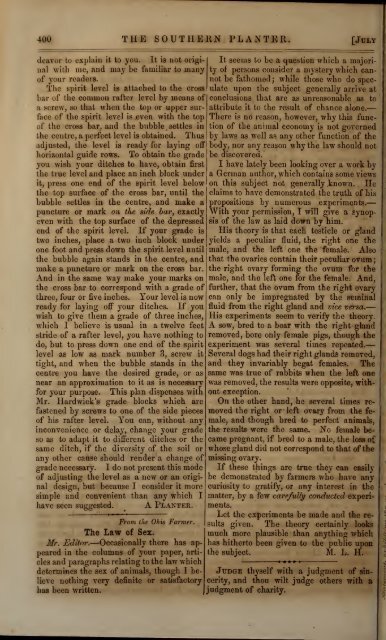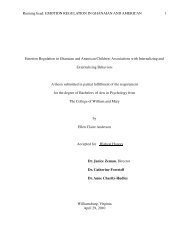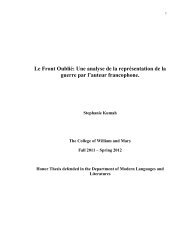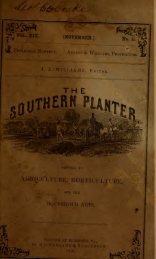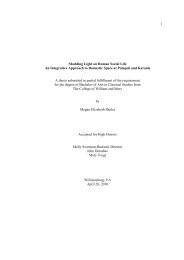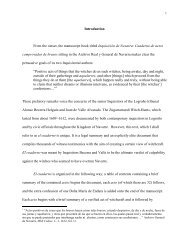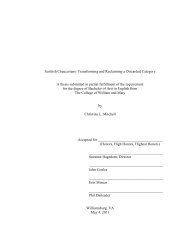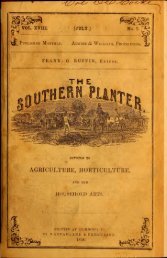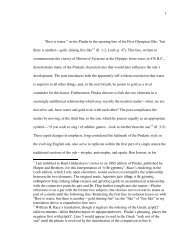Southern planter - The W&M Digital Archive
Southern planter - The W&M Digital Archive
Southern planter - The W&M Digital Archive
You also want an ePaper? Increase the reach of your titles
YUMPU automatically turns print PDFs into web optimized ePapers that Google loves.
400 THE SOUTHERN PLANTER [July<br />
deaYor to explain it to you. It is not origi- It seems to be a question which a majorinal<br />
with nie, and may be familiar to many ty of persons consider a mystery which can-<br />
of your readers.<br />
not be fathomed; while those who do spec-<br />
<strong>The</strong> spirit level is attached to the cross ulate upon the subject generally arrive at<br />
the common rafter level by means of conclusions that are as unreasonable as to<br />
bar oi %<br />
a screw, so that when the top or upper sur-<br />
face of the spirit level is even with the top<br />
of the cross bar, and the bubble settles in<br />
the centre, a perfect level is obtained. Thus<br />
adjusted, the level is ready for laying off<br />
horizontal guide rows. To obtain the grade<br />
you wish your ditches to have, obtain first<br />
the true level and place an inch block under<br />
it, press one end of the spirit level below<br />
the top surface of the cross bar, until the<br />
bubble settles in the centre, and make a<br />
puncture or mark on the side bar, exactly<br />
even with the top surface of the depressed<br />
end of the spirit level. If your grade is<br />
two inches, place a two inch block under<br />
one foot and press down the spirit level until<br />
the bubble again stands in the centre, and<br />
make a puncture or mark on the cross bar.<br />
And in the same way make your marks on<br />
the cross bar to correspond with a grade of<br />
three, four or five inches. Your level is now<br />
ready for laying off your ditches. If you<br />
wish to give them a grade of three inches,<br />
which I believe is usual in a twelve feet<br />
stride of a rafter level, you have nothing to<br />
do, but to press down one end of the spirit<br />
level as low as mark number 3, screw it<br />
tight, and when the bubble stands in the<br />
centre you have the desired grade, or as<br />
near an approximation to it as is necessary<br />
for your purpose. This plan dispenses with<br />
Mr. Hardwick's grade blocks which are<br />
fastened by screws to one of the side pieces<br />
of his rafter level. You can, without any<br />
inconvenience or delay, change your grade<br />
so as to adapt it to different ditches or the<br />
same ditch, if the diversity of the soil or<br />
any other cause should render a change of<br />
grade necessary. I do not present this mode<br />
of adjusting the level as a new or an original<br />
design, but because I consider it more<br />
simple and convenient than any which I<br />
have seen suggested. A Planter.<br />
From the Ohio Farmer.<br />
<strong>The</strong> Law of Sex.<br />
Mr. Editor.—Occasionally there has appeared<br />
in the columns of your paper, articles<br />
and paragraphs relating to the law which<br />
determines the sex of animals, though I be-<br />
lieve nothing very definite or satisfactory<br />
has been written.<br />
attribute it to the result of chance alone.<br />
<strong>The</strong>re is no reason, however, why this function<br />
of the animal economy is not governed<br />
by laws as well as any other function of the<br />
body, nor any reason why the law should not<br />
be discovered.'<br />
I have lately been looking over a work by<br />
a German author, which contains some views<br />
on this subject not generally known. He<br />
claims to have demonstrated the truth of his<br />
propositions by numerous experiments.<br />
With your permission, I will give a synopsis<br />
of the law as laid down by him.<br />
His theory is that each testicle or gland<br />
yields a peculiar fluid, the right one the<br />
male, and the left one the female. Also<br />
that the ovaries contain their peculiar ovum;<br />
the right ovary forming the ovum for the<br />
male, and the left one for the female. And,<br />
further, that the ovum from the right ovary<br />
can only be impregnated by the seminal<br />
fluid from the right gland and vice versa.—<br />
His experiments seem to verify the theory.<br />
A sow, bred to a boar with the right gland<br />
removed, bore only female pigs, though the<br />
experiment was several times repeated.<br />
Several dogs had their right glands removed,<br />
and they invariably begat females. <strong>The</strong><br />
same was true of rabbits when the left one<br />
was removed, the results were opposite, without<br />
exception.<br />
On the other hand, he several times removed<br />
the right or left ovary from the female,<br />
and though bred to perfect animals,<br />
the results were the same. No female became<br />
pregnant, if bred to a male, the loss of<br />
whose gland did not correspond to that of the<br />
missing ovary.<br />
If these things are true they can easily<br />
be demonstrated by farmers who have any<br />
curiosity to gratify, or any interest in the<br />
matter, by a few carefully conducted experiments.<br />
Let the experiments be made and the re-<br />
sults given. <strong>The</strong> theory certainly looks<br />
much more plausible than anything which<br />
has hitherto been given to the public upon<br />
the subject. M. L. H.<br />
Judge thyself with a judgment of sin-<br />
cerity, and thou wilt judge others with a<br />
judgment of charity.<br />


